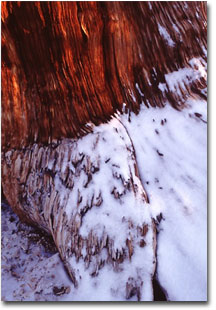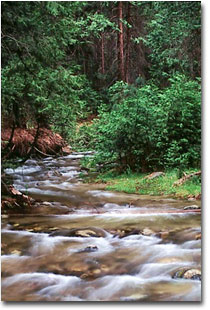|
|

Artist's Perspective... Focus on Photographic Opportunity
Text and Photography Copyright Dale Proctor
It really doesn't matter what time of year it is when we go outdoors for nature photography. What matters most to photographers is how we see the light and how we handle the photo opportunities we encounter. When in the field we really are dependent on mother nature and weather conditions, what I call the natural elements. Just being in tune with our surroundings, getting in touch with nature, how she feels whether bright and cheery or doom and gloom is not enough. If we are not comfortable, feeling good about being out in the elements, our mind will be preoccupied with how we are feeling physically. How in the world can we focus on the beauty outdoors in nature when we are not fully in tune and able to make this valuable connection? One way to do this connecting is get outside as often as possible, take hikes, and explore those nature scenes you want to photograph. When out in the field look in all directions, not just where you are going, but also where you have been. Walk around potential subjects, see how they look from more than one angle, especially when you have sidelight. This sidelight can be soft and subtle or strong, intense and dramatic directional light entering the scene from the side. Many times I have found views I would have never seen had I stuck with being on the trail wearing blinders. When you look, discover more than just a tree, find and photograph an entire grove of trees. Walk around and find the leader of this community, the best specimen or candidate for your great intimate portrait. Remember, what you see that attracts you to photograph is what you will need to emphasize with your photography. Using a tree as an example, getting close, low and vertical with a short focal length lens will speak the concepts strong, stable, majestic, and powerful to viewers. Using branches as lines in strong diagonal placement will help drive viewer's eyes with your composition. A small tilt of the lens here will exaggerate the perspective just enough to make a subtle difference. I must warn you though, to much angle when employing a wide lens is often detrimental to your photographs success. As was mentioned in another article, temper use when using short focal length lenses but don't ever temper your use of creativity.
In nature photography it is the subtle things we must look for, a slight variance from the norm. Just a little bit more than normal water flowing, rushing up the banks of a river or creek. High water is cause for erosion of old weathered sun baked earth and rock crust, exposing new color from below and showing textures along waters edges. Extended periods of dry weather may cause puddles in dry creek beds, cracked mud, rounded river rock smoothed from waters mighty power. Sand textures lay waiting for our lenses. These and more opportunities you will not find everyday. These are the scenes we should be photographing, scenes others pass by because they don't see the beauty that is there. And yes, I can hear some chuckles about the beautiful mud pictures. If Edward Weston could make a beautiful photograph of a toilet, which is hanging in art galleries, we surely can make beautiful pictures of mud! Just because the light turns bland doesn't mean you have to stop photographing. We just need to be much more selective as to what we photograph or suffer the consequences. In Photo 1, I had been photographing quality morning light at 12,000' high in the White Mountains. The sun broke over the eastern horizon in a glorious crimson red. High cloud cover was glowing bright pink, it was awesome. One of those mornings where you can't believe you're out in this incredible light and your camera is all set up. Finally, you're in the right place at the right time! Had I not scouted this area the morning before, I may have been frustrated as I scrambled for position. Here I turned to the intimate scene, the base of a pine tree covered in fresh morning snow. As I hiked along Bubb's Creek in Kings Canyon (Photo 2) for a place to cross, I looked back and noticed the nice "s" curve as the creek emerged from the conifer forest. This is actually winter snow melt running down from the high country and joining Bubb's Creek before spilling into the South Fork Kings River. We already know how a scene looks to our eyes, how will that scene look though our lens? One thing is for sure, the lens sees differently than the eye. This is a topic we will be discussing with a nice excercise to help us see like the lens does. Just another of those little details between the photographer, the scene, and film. Editor's Note - Visit Dales web site at www.californiapictures.com to view more of his work. DP - NPN 368 Comments on NPN California landscape photography articles? Send them to the editor. |
|
|
 PHOTO 1 - Exploring the Ancient Bristlecone Pine tree forest in the White Mountains of California, I found nice textures showing in the base of these old warrior trees. Knowing we were in for a morning snow storm, I planned on shooting several trees in softer light. Little did I know the softer light would be a magical pink. Morning sun filtering through nearby branches made for nice color and great contrast. Nikon N6006, Nikkor 35-70mm 2.8, Velvia, Tiffen cir. polarizer, Bogen 3001 w/3047, cable release, exposure unrecorded.
PHOTO 1 - Exploring the Ancient Bristlecone Pine tree forest in the White Mountains of California, I found nice textures showing in the base of these old warrior trees. Knowing we were in for a morning snow storm, I planned on shooting several trees in softer light. Little did I know the softer light would be a magical pink. Morning sun filtering through nearby branches made for nice color and great contrast. Nikon N6006, Nikkor 35-70mm 2.8, Velvia, Tiffen cir. polarizer, Bogen 3001 w/3047, cable release, exposure unrecorded.
 PHOTO 2 -To avoid highly reflective rocks along the left edge of this fast rushing creek, I zoomed in tight using a telephoto lens in vertical format. Being a high contrast scene, I choose not to use a polarizing filter. This action allows for more shadow detail, which was needed in this lighting situation. Nikon N90s, Nikkor 80-200mm 2.8, Fujichrome 100 RDP, Hoya 81B, Bogen 3021 w/3047, release, exposure unrecorded.
PHOTO 2 -To avoid highly reflective rocks along the left edge of this fast rushing creek, I zoomed in tight using a telephoto lens in vertical format. Being a high contrast scene, I choose not to use a polarizing filter. This action allows for more shadow detail, which was needed in this lighting situation. Nikon N90s, Nikkor 80-200mm 2.8, Fujichrome 100 RDP, Hoya 81B, Bogen 3021 w/3047, release, exposure unrecorded.